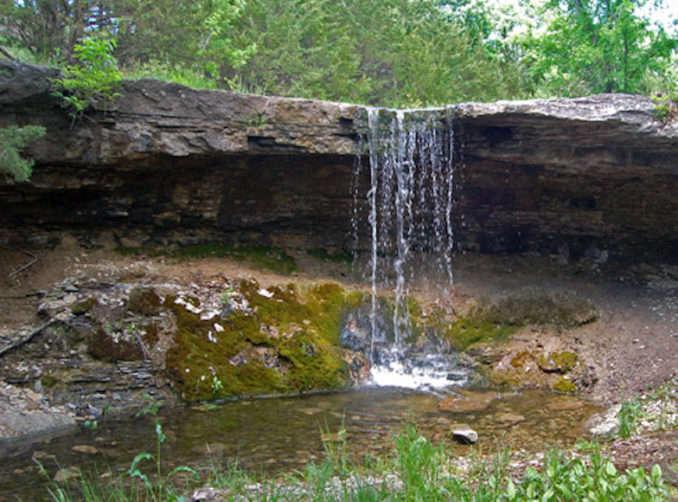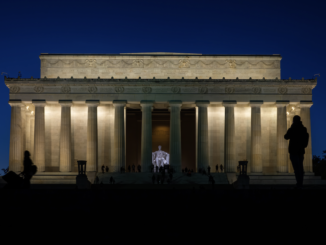Second in a series by my uncle John Alldridge. This article first appeared in the Derby Evening Telegraph in December 1967 – Jerry F
We slept that first night at Alcove Springs, a straggling thicket of birch and pine, tucked away in a hollow of the prairie 40 miles or so from the Kansas-Nebraska state line.
It is a pleasant place to camp at any time. There is fresh spring water, shade from the everlasting glare of the sun, shelter from the wind, dry wood for a fire.
There is only one disconcerting note. A wooden sign-board, roughly painted, cautions “No Firearms.”
To the men and women of the wagon trains, greenhorns learning the hard way, it must have seemed like Paradise.
They had now been on the trail three weeks. They had started out in May, the wettest time of the year, and frequent prairie squalls, with high winds and hail, had made the low places soft.
So they struggled up along the ridges. Besides it was safer on the higher ground in Indian country, for down in the wooded hollows the Pawnees waited to pounce.
Sometimes, during dry spells, the Indians started grass fires in the hope of starving the plodding oxen and mules.
Often they attacked lone straggling wagons, and in the middle of the night would come whooping down on a wagon train.
So they learned to corral their wagons at night, locking them into a hollow circle.
There were rivers to cross — now no more than muddy trickles — which meant frustrating delays.
So the more impatient of them caulked their wagon-beds, stripped off the wheels and rowed across.
By the time they reached Alcove Springs — near what is now Marysville on the Blue River — they were already seasoned pioneers.

Alcove Springs,
PowercatPark – Licence CC BY-SA 4.0
Alcove Springs takes its name from the shelf of rock over which in early spring an infant torrent poured to fill a fair-sized stream.
The animals were let loose in the meadow above, where the grass was green and tender, and the wagons were man-handled through the little wood.
When we arrived the stream was almost dry, but the ruts of the wagon wheels were as clearly marked as if they had been made yesterday.
I climbed up on the rock of the Alcove, highly polished now and carved with many names and initials. I traced them with my finger until I found it spelling out an ominous word — “Death.”
Was this a name — De’Ath, perhaps? There are many De’Aths in England. Or could it have been left there by some emigrant who had a sudden premonition of what lay ahead?
For death was a familiar fellow-traveller on the Oregon Trail. The road they took is marked with pathetic gravestones.
In 1849 something like 50,000 emigrants, all of them in a hurry, followed the trails west.
That year the Oregon Trail saw a procession of wagon-trains so continuous that the lead-wagon of one train was frequently not more than a few hundred yards ahead of the next.
It was a spring of constant rain — of deep mud, of wet food, blankets and clothing, of head colds and cholera.
Perhaps 5,000 Forty-niners died of cholera before they reached the high plains. And there were foolhardy ones who insisted against all advice, in going it alone.
In the spring of 1846 a party of 90 men, women and children, sponsored and led by two wealthy Illinois brothers, the Donners, camped here for five days.
One of them, Sarah Handley Keyes, a woman in her 70s, died and was buried here. She was one of the lucky ones.
Weeks later the headstrong Donners decided to leave the regular route at Fort Bridger and take a short cut south-west to Salt Lake and thence — they hoped — to San Francisco.
This was an almost impossible route for wagons — over the terrible Salt Lake Desert, the almost awesome Nevada Desert, and the High Sierras.
Yet somehow they staggered on across the fiery deserts, suffering agonies of thirst. But by the time they reached the Truckee River and the foothills of the Sierras they were far behind schedule.
It was late October now. Despite that they prepared to climb the cruel 2,000ft. granite ridges of the Sierras, hauling their wagons behind them.
Before they were half-way up they were halted by the first winter blizzard. Soon the mountains were deep in snow.
Huddled together like terrified animals by a frozen lake that now bears their name, the wretched Donners were reduced to living on twigs and bark.
Before the end of that awful winter they had turned cannibal and were eating their own dead . . .
Of the 89 who set out from Fort Bridger at the end of July, only 45 were still alive when a search party finally found them in February.

Donner Party Memorial statue,
Seano1 – Licence CC BY-SA 3.0
The disaster to the Donner party was the worst tragedy in the 30 years of the Oregon Trail.
But all those pathetic headstones, carved hastily and in grief, for 2,000 miles tell their own unrecorded story . . .
NEXT: Fort Kearny, last link with civilisation.
© Reach plc, courtesy of The British Library Board
Jerry F 2022



